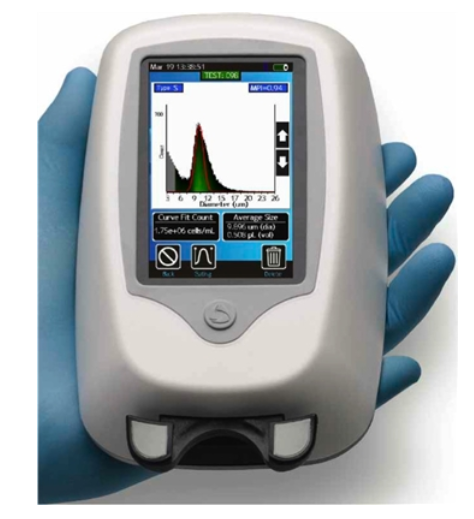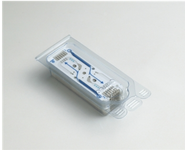Moxi Z Mini Automated Cell Counter
Moxi Z Cell Counter – Industry leading cell count accuracy, precision and simplicity.
Improve downstream results with better quality control.

Moxi Z is the only automated cell counter that combines the Coulter Principle typically used in high-end cell counters with a patented thin-film sensor technology to allow for highly accurate (> 95%) and repeatable particle counting and sizing for a broad range of cell types – from mammalian cells to cells as small as wine yeast and more. Since today’s workflows demand accurate quality control of samples, determining cell counts precisely has a significant impact on outcomes and downstream costs.
Produce repeatable cell counts with >95% accuracy in just 8 seconds.
This ultra-small instrument uses patented microfluidic thin-film cassettes that enable automatic load and measure operation. The resulting single cell volumetric measurements are completely technique-independent. It provides the ideal alternative to the tedious manual counting associated with cytometers, or the inaccurate results associated with image-based automated cell counters (typical accuracies of 75-80%).
Assess cell culture health without reagents or dyes.
Moxi Z also automatically reports a unique cell health assessment index – MPI (Moxi Population Index) – without the need for reagents or dyes. MPI is a ratio of the cell population of interest relative to the entire particle distribution in that sample, factoring in dead cells that have shrunken or broken apart as well as other debris and contaminants in the sample. For monodisperse mammalian cultures this is closely correlated to the overall health of the sample.In the case of mixed cell populations, it’s provides an assessment of the relative fraction of the largest sized population in the sample. Unlike staining-based viability methods that focus on the uptake by dead cells and do not account for contaminants and other debris, MPI provides insight on the primary population of interest (based on size) and its relationship to ALL other particles in the sample.
Measure the smallest cells at very high concentrations.
Using the new Type S cassette, you can now accurately measure the smallest cells of any automated cell counter (down to 3um average diameter) at concentrations of up to 2.5e+6/ml. This means the new Type S cassette can measure Yeast (including wine yeast) and non-spherical particles down to 14 fL in volume.
Results in just 8 seconds
- Ultra-small and ultra-easy to use (no manual counting, no focusing of any kind)
- Complete, high-resolution cell size/count histogram
- Handles “de-aggregation” and coincidence events
- Post-processing/analysis of count distributions with user-adjustable regions/gates
- Assess cell health (MPI) without the need for reagents like Trypan blue.


Specifications
| id | MXZ001 |
| Included Accessories | Instrument Only |
| AC Power Type | 110 VAC |
| Applications | Cell Counting|Cell Size|Cell Health |
| Average Cell Diameter Range | 4 – 25 microns Type M|3 – 20 microns Type S |
| Battery Type | Rechargeable 3.7 V, 4400 mAh lithium ion |
| Cassette Types | Type M|Type S |
| CE Certification | Yes |
| Cell Particle Concentration Range | 3,000 – 500,000 cells/mL Type M|3,000 – 1,750,000 cells/mL Type S |
| Cell Types Tested | HEK-293|HeLa|PC12|CD3+T|CHO-K1|Cos-7|HepG2|Hybridoma|Jurkat E6-1|K562|MCF7|Mesenchymal SC|Monocyte|Mouse ESC| NIH 3T3| PBMC (cultured)|Red Blood Cells (RBC)|L5178y| C. albicans (Yeast)| S. cerevisiae Vin 13 (Yeast)|S. cerevisiae X5 (Yeast)|Wine Yeast (natural fermentaion)|S.cerevisiae (Baker’s Yeast|Safale US-05 Yeast| |
| Compatible Instruments | MOXI Z |
| Data Output Formats | .csv format (Orflo MoxiChart or Microsoft Excel) |
| In British Units | 1.5 lbs |
| Intended Use Statement | For Research Use Only. Product is not for use in diagnostic procedures |
| Measurable Dynamic Range | 2- 34 microns Type M|2 -26 microns Type S |
| Measurement Time | 15 seconds Type S|10 seconds Type M |
| MPICell Health Ratio Moxi Viability Index MVI | Yes |
| Number of Detection Channels Flow parameters | 1 |
| Overall Dimensions | 7.6 L x 4.3 W x 2.8 H (in) |
| Particle Size Detection Method | Impedimetric (Coulter Principle) |
| Platform | No |
| Pre-Programmed Tests | None |
| Sample Type | Mammalian Cells|Large Yeast|Large Algae|Protozoa Type M/ Mammalian Cells|Most Yeast|Small Algae|Small Protozoa Type S |
| Sample Volume | 75 µL |
| Supported Connectivity | USB on-the-go; PC or Mac compatible; requires Windows XP, Windows Vista, Windows 7, or Mac OS X operating system |
| Useable Cell Volume | 34 – 20,580 fL Type M|14 – 4,200 fL Type S |
| Weight | 0.68 kg |
How It Works
Electronic current is passed through a small hole (Cell Sensing Zone) in a thin-film membrane. Cells flow substantially single file through the CSZ causing momentary increases in measured voltage that are directly proportional to cell or particle volume. Thousands of cells are measured during a single test and the size of each cell is plotted and saved in histogram format. Total volumetric counts are determined by precisely measuring the volume of fluid being analyzed.
 Finished! Automatic, hands-free measurement in just 8 seconds.
Finished! Automatic, hands-free measurement in just 8 seconds.
Note: Each cassette holds 2 tests. When Sample 1 is complete, simply re-insert other end of cassette into Moxi Z, and load Sample 2.
Data
For each measurement, a complete histogram is displayed as well as cell count, average cell size and Moxi Population Index. The raw waveform from the most recent cell count, containing each cell spike, is also stored on the Moxi Z and can be both viewed on the Moxi Z and uploaded to the PC for additional analysis. The Moxi Z also performs sophisticated curve fitting analysis to more accurately determine cell counts in the event of overlapping populations of cells (or debris), significantly improving the accuracy of the volumetric counts produced by the Moxi Z. Data for 500 samples may be stored on the unit. All data can be transferred to a PC/Mac via Bluetooth. No special software is required for the PC since date files are Excel®-compatible. Sophisticated PC/Mac compatible analys software is included with each Moxi Z. Cell health may be assessed by comparing differences in histograms from culture to culture.
Resources:
Application Notes:
- Moxi Z Performance Benchmarks
- Demonstrates that Moxi Z matches the performance of the “Gold Standard” in Counting technologies
- Moxi Z Comparison to High-End Coulter Counter and Imaging System
- Shows the superior accuracy and precision of the Moxi Z relative to imaging systems, performance that matches the “Gold Standard” in Counting technologies
- Moxi Z Blood Cell Analysis
- Demonstrates how Mozi Z can be used for Blood cell analysis of both WBC and RBC cell types
- Moxi Z – Monitoring Cell Culture Health
- Describes how Mozi Z and its MPI functionality can be used to monitor cell culture health, contaminantion, and CO2 levels quickly and easily
- Moxi Z Yeast and Craft Beer Info Sheet
- A short summary of the importance of measuring yeast populations in craft beer and wine making and why the Mozi Z is perfect for doing it. Piece includes links to back to Orflo’s website application link pages that detail the information for varous yeast strains.
- Moxi Z Algae Cell Counting Article
- An extract from a Genetic Engneering News article that examined algae growth and measurement utility using the Moxi Z
- Moxi Z Yeast Craft Beer Monitoring
- An application and protocol complete with pictures demonstrating how to use Moxi Z to count yeast in various stages of beer production.
Protocols:
- Moxi Z System Check Bead Protocol
- Step by step guide demonstrating how to run a system check using calibrated bead sets with the Moxi Z device and Type S or Type Mcassettes.
- Moxi Z Firmware Update Instructions
- Step-by-step guide to updating your Moxi Z Flow Operating System using a standard USB connection or with a Bluetooth connection using the MoxiChart software.
- Moxi Z Total WBC Count Protocol
- Step by step instructions for staining with Annexin V (Apoptosis) and PI (Viability) using the Moxi Flow device.
- Moxi Z – BlueTooth Instructions for Windows XP
- Step by step informational piece that guides users in how to set up Windox XP based machines to communicate with Moxi Z via Bluetooth Technology
- Buffy Coat with RBC Lysing Protocol
- Step by step protocol for collecting a whole blood specimen and preparing a buffy coat cell suspension for later analysis in the Moxi Flow or Moxi Z devices
- Moxi Z Mamallian Cell Sample Preparation Guide
- Step by step protocol for preparing mammalian cells for use in the Moxi Z device
Brochures:
Citations:
- ORFLO Citations
- Up to date collection of citations of the use of the ORFLO instruments and reagents in peer reviewed Journal articles.
Videos:
